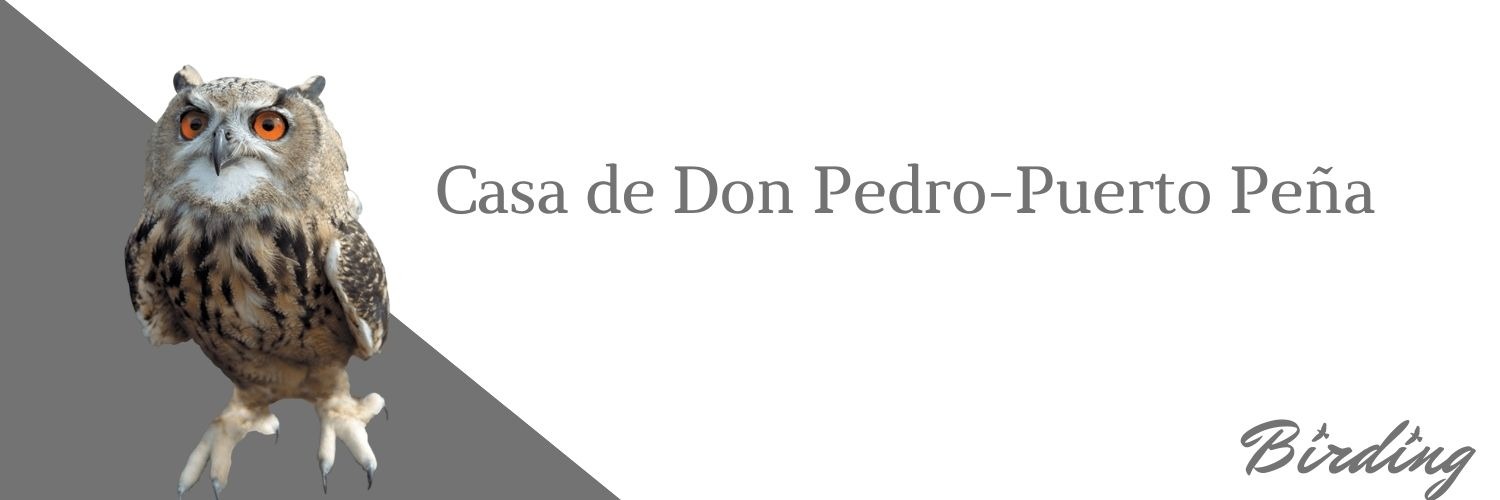Birding
Extremadura es considerada por los ornitólogos uno de sus destinos europeos preferidos. La dehesa predominante en estas regiones es la causa de que haya 377 especies de las cuales 194 son reproductoras tanto sedentarias, que viven todo el año en este lugar, como las que nidifican y que migran a otro lado a pasar el invierno. Destacan en este hábitat especies protegidas como el águila imperial, el buitre negro, el águila perdicera, el alimoche, el aguilucho, la avutarda o el cernícalo.
Rutas para birding

Puerto Peña - Puebla de Alcocer
Cruzando el muro de la presa de García de Sola, tomaremos un desvío a la derecha por la carretera BA-138 hacia Talarrubias. Sin entrar en el pueblo continuaremos hasta incorporarnos a la EX103 en dirección a Puebla de Alcocer. A las afueras de Puebla de Alcocer y a la izquierda de la carretera se encuentran las ruinas del Convento de la Visitación, que acoge una espectacular colonia de Cernicalos primillas. Tambien nidifican en el edificio cigueñas blancas, mochuelos comunes, vencejos comunes y vencejos pálidos.
El recorrido por el Canal de las Dehesas hacia Puerto Peña atraviesa principalmente zonas de dehesas y pastizales, observandose especies representativas como elanio azul, ratonero común, águila perdicera, águila calzada, milano negro, grulla común rabilargo, abubilla, alcaudón común, cogujada montesina, etc. Unos 5 km antes de llegar al camping se encuentra una enorme colonia de garzas que acoge a más de 2.000 parejas. En ella nidifican diversas especies como garcilla bueyera, garceta, martinete, garza real, garcilla cangrejera (sólo confirmada algunos años) y cigüeña blanca. La colonia se sitúa en una gran isla cubierta de atarfes en la que también se pueden ver chorlitejos chicos, gaviotas reidoras o pagazas.

Casa de Don Pedro-Puerto Peña
Para llegar tomaremos la carretera BA-137 dirección a Talarrubias. Apenas 1 km después de haber pasado las ultimas casas del pueblo, encontraremos un cruce con una carretera asfaltada que discurre paralela al Canal de las Dehesas. Tras pasar 2.250m encontraremos a la izquierda un camino de tierra (frente a una de las compuertas de regulación). Después regresaremos de nuevo al cruce con la BA-137 y continuaremos por la carretera de servicio del canal a lo largo de más de 15 km, hasta llegar a un cruce que nos permite volver a la N-430 o al Camping “Puerto Peña”. Al lado del Camping se encuentra el Centro de Interpretación de la Fauna Rupícola de Puerto Peña.
El recorrido por el Canal de las Dehesas hacia Puerto Peña atraviesa principalmente zonas de dehesas y pastizales, observandose especies representativas como elanio azul, ratonero común, águila perdicera, águila calzada, milano negro, grulla común rabilargo, abubilla, alcaudón común, cogujada montesina, etc. Unos 5 km antes de llegar al camping se encuentra una enorme colonia de garzas que acoge a más de 2.000 parejas. En ella nidifican diversas especies como garcilla bueyera, garceta, martinete, garza real, garcilla cangrejera (sólo confirmada algunos años) y cigüeña blanca. La colonia se sitúa en una gran isla cubierta de atarfes en la que también se pueden ver chorlitejos chicos, gaviotas reidoras o pagazas.

Puebla de Alcocer - Cogolludo - Orellana la Vieja
Una vez ubicados en el Mirador de Puerto Peña, seguiremos en dirección a Peloche-Herrera del Duque. Cruzando el muro de la presa de Garcia Sola y 200m más adelante, tomaremos un desvío a la derecha por la carretera BA-138 hacia Talarrubias. sin entrar en el pueblo continuaremos hasta incorporarnos a la EX-103 en dirección a Puebla de Alcocer. A las afueras de Puebla de Alcocer y a la izquierda de la carretera (800 m después de la gasolinera) se encuentran las ruinas del Convento de la Visitación, que acoge una espectacular colonia de Cernícalos primillas. También nidifican en el edificio cigüeñas blancas, mochuelos comunes, lechuzas comunes, vencejos comunes y vencejos pálidos.

Orellana la Vieja - Puebla de Alcocer
Tras finalizar la Ruta 3, desde Orellana la Vieja tomaremos la EX115 hacia Campanario y La Coronada pasando por por el muro de la presa del Embalse de Orellana y tras recorrer unos 5 km llegaremos al cruce de la EX103, que nos lleva directamente a Puebla de Alcocer. Este tramo del total de la ruta es el mejor para la observación de las aves estepáricas, ya que la mayor parte del recorrido por la EX103 discurre por zonas de pastizales naturales y cultivos de cereal. Durante el período reproductor podremos observar con facilidad avutardas, sisón cernícalo primilla o aguilucho cenizo.
Es fácil también observar carracas, abubillas, mochuelos, alcaravanes ganga, ortegas y canasteras. En los pastizales son muy abundantes la calandria común, la cogujada montesina, el buitrón triguero y el gorrión moruno. En invierno destaca la presencia de chorlito dorado, avefría, bisbita común y lavandera blanca

